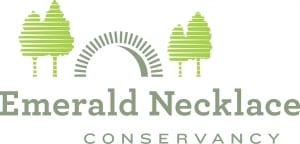One of Olmsted’s great accomplishments in designing the Emerald Necklace was creating the illusion of a natural environment despite the meticulous plans for engineering, construction and planting. Today the conservancy, in conjunction with public and private partners, organizes and implements maintenance initiatives to preserve the naturalistic beauty of Olmsted’s parks as well as maintain the gardens and pathways added in later years.
Kelleher Rose Garden, Back Bay Fens
The decade-long restoration of the historic Arthur Shurcliff rose garden by the conservancy and the Boston Parks & Recreation Department in the Back Bay Fens continues. To date, thousands of new roses have been planted and attractive and informative signs put in place, all of it lovingly cared for by an enthusiastic team of volunteers who attend the conservancy’s popular “Tuesdays with Roses” evenings. The capstone element of the project is restoration of the rose garden fountain to the original Shurcliff-era design. Kelleher Rose Garden brochure.
The Woodlands, Olmsted Park
In 1886, Olmsted wrote “mainly the value of a park depends on the disposition and quality of its woods, and the relations of its woods to other natural features.” With this guiding principle in mind, our work preserving the woodlands for future generations moved forward last year in a 3-acre woodlands pilot plot just south of Leverett Pond where volunteers are removing invasive plants and rejuvenating the soil. In 2006, we launched the woodlands restoration project, removing invasive Asiatic Bittersweet, Buckthorn, Garlic Mustard and Japanese Knotweed, and began planting to regenerate the forest canopy and to enrich the understory. Results from this project will inform and guide future work throughout the woodlands of the Emerald Necklace.
Maintenance Collaborative
The Maintenance Collaborative was conceived by the conservancy with the Massachusetts Department of Correction, and Boston and Brookline parks departments to provide essential maintenance work in the parks through a pre-release vocational training program. The program equips crew members with job skills that will facilitate re-entry into the workforce and their communities. Crews receive classroom and on-the-job training in horticulture and landscape maintenance from professionals, and make a contribution to society by maintaining the park landscape. Generously supported by the Bank of America Charitable Foundation and the Cummings Foundation.
Maintenance Collaborative blog
Invasive Species Management
The Emerald Necklace Conservancy has taken significant steps to limit the negative effects of invasive species within the Emerald Necklace park system with the help of volunteers at regularly scheduled maintenance events.
See upcoming volunteer events.
Invasive species are plants and animals that can displace native species and have long-lasting or even permanent negative effects on habitats and the organisms that depend on them. They alter landscapes and fundamental ecosystem processes. They threaten biodiversity and damage infrastructure.
Some invasive plants and animals encountered in the Emerald Necklace are: Japanese Knotweed, Asiatic Bittersweet, Garlic Mustard, Wild Rose, Buckthorn and Canada Geese.
The National Invasive Species Council can provide detailed information if you are interested in learning more about invasive species.



